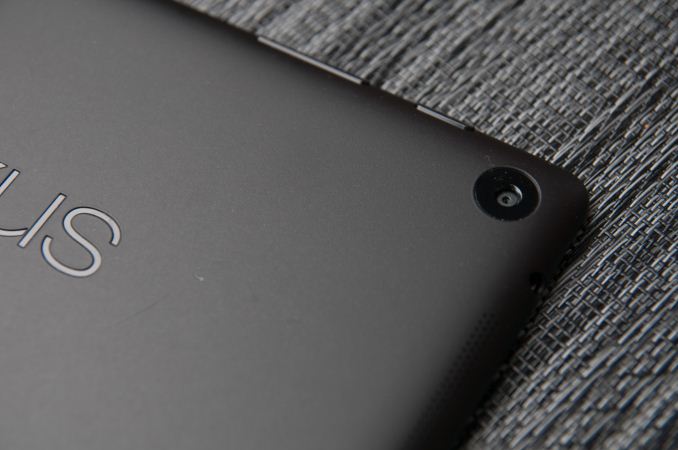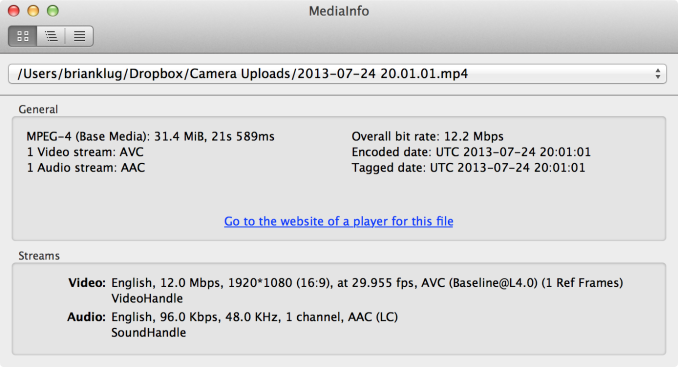Nexus 7 (2013) - Mini Review
by Brian Klug on July 27, 2013 12:54 AM EST- Posted in
- Tablets
- Snapdragon
- Qualcomm
- Android
- Mobile
- APQ8064
- Nexus 7
- Android 4.3
The lack of a rear camera on the original Nexus 7 was always a bit of a downer. It clearly had the space for a module inside, but including a camera didn’t align with the efforts to drive that device into the price point that made it successful. With the new Nexus 7 we finally get a camera, and a 5 MP one with autofocus at that. Inside the camera is an OV5693 sensor, which best I can tell is a 1/4" format sensor with 1.4 micron pixels. It might not be the world’s best camera, but it’s no slouch either.
I took a handful of photos and videos with the Nexus 7 (2013) to gauge camera quality, and even if this isn’t necessarily a device with focus on imaging it’s not bad at all. I came away pretty pleased for what kind of camera it is. Even though I still strongly believe that you shouldn’t be using a tablet to take photos you intend on using for anything more than sharing on social networks, in this brave new era of mobile devices it’s a feature every tablet and smartphone does need.
I’ll save you the discussion once again about how the Android 4.3 camera UI continues to present a 16:9 aspect ratio crop of the 4:3 image captured by the sensor, which results in a smeary looking, inaccurate preview.
Video on the Nexus 7 (2013) is 1080p30 at 12 Mbps, H.264 Baseline with 1 reference frame, and 96 kbps 48 KHz single channel AAC audio. I've uploaded a sample I took in SF to our servers as well as YouTube. Again I’m dismayed why more OEMs don’t use the full encode capabilities of APQ8064 (20 Mbps H.264 High Profile) but that’s what it is by default on the new Nexus 7.



















252 Comments
View All Comments
Roland00Address - Saturday, July 27, 2013 - link
The only thing this mini review is lacking compared to a normal review is the battery tests, that and the writer felt rush but Brian did a great job with such limited time.thesavvymage - Sunday, July 28, 2013 - link
Anand will personally be doing an incredibly in-depth analysis of nearly everything this tablet has to offer in the near future. You should go look up one of anand's iPad reviews, they are probably 3 or 4 times as long as this one. He does an amazing jobchrone - Saturday, July 27, 2013 - link
Great reviews as always. Does it still have transition animation micro stuttering when autobrightness is on and in outdoor?psyside1 - Saturday, July 27, 2013 - link
Can anyone tell me, is the unit tested 16 or 32GB version? i never saw clarification about it, which is the only thing missing in this review, other then that fantastic job.Also how much faster should the 32GB model be, if this one was 16GB version? (knowing flash benefit from size) 16 vs 32GB, might be nice to see for the future Anand review.
Krysto - Saturday, July 27, 2013 - link
Why would flash benefit from size? Either way, there shouldn't be major differences in speed.psyside1 - Saturday, July 27, 2013 - link
Why bigger SSD/USB drives, are always faster then smaller?Krysto - Saturday, July 27, 2013 - link
They might, but I doubt it has anything to do with the size, and more with the manufacturer's "strategy" of making higher store that is more expensive, also have higher speed.But that's like saying cameras with more MPs are automatically better because they have more MP's, when in fact they are usually better because the camera makers work in parallel to also improve the overall quality of the camera module, while increasing the MP count, too, for the next generation cameras.
Death666Angel - Saturday, July 27, 2013 - link
You should educate yourself on that one, your first statement is clearly wrong. The way SSDs get their exceptional speed is by using packages of NAND in parallel. And how many packages of NAND an SSD has directly corresponds to the size of the SSD. Look up a few reviews of SSDs on Anandtech and you will get a break-down of packages vs size, the one of the 840 EVO being a great example to study because of the inclusion of all sizes. It is not just an arbitrary decision to justify the price tag. The explanation is in the technology, not in the marketing this time.psyside1 - Sunday, July 28, 2013 - link
http://www.anandtech.com/show/6130/the-16gb-nexus-...How about you educate your self, instead of me? thanks.
Bast - Sunday, July 28, 2013 - link
Actually he's right. your link is not relevant as the eMMC devices most probably use only one chip and no parallel controller like SSDs do. In addition, in HDDs, the higher storage is because of higher densities of data on platters that rotate at the same speed as lower capacity drives which translates to higher rates.